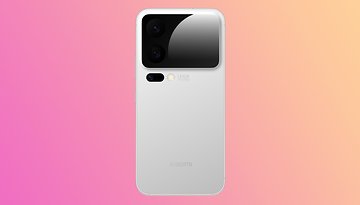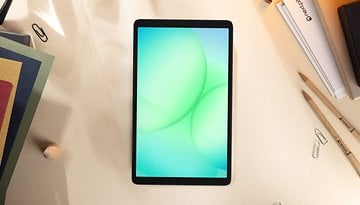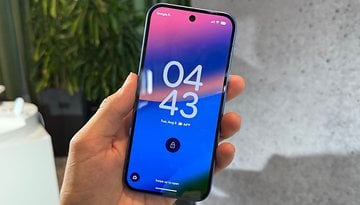HyperOS 3 Arrives with Big Features—Is Your Xiaomi Device on the List?
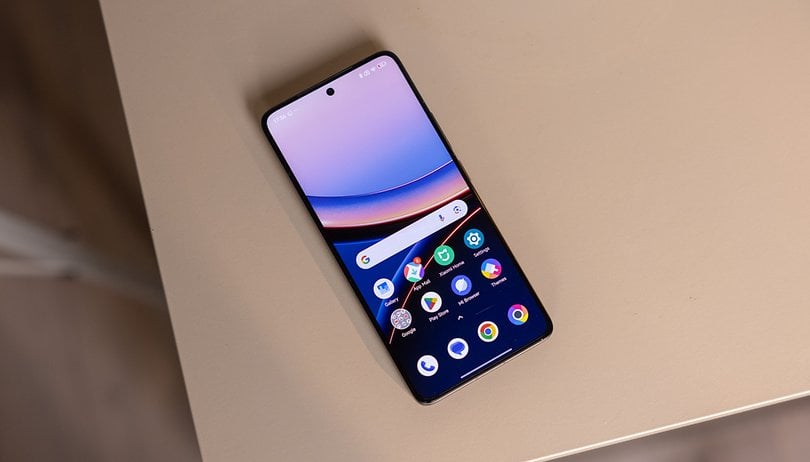

Xiaomi made a big splash when it announced HyperOS 3.0, built on Android 16. This was followed by a beta release and then the final update, which began rolling out to devices, including global models, in September. In this article, discover the major features of HyperOS 3.0, its release schedule, and the full list of devices set to receive the update.
What’s New in HyperOS 3.0
Xiaomi's HyperOS 3.0 is its latest major software update built on Android 16. It inherits core improvements from Google’s latest Android release. But the company isn’t just skinning Android, it’s adding its own meaningful features and design changes across smartphones, tablets, and wearables.
iOS-Inspired Icons, Super Island, and a Cleaner Layout
The interface gets a fresh look with simplified app icons that resemble iOS, featuring square shapes with rounded corners. The status bar and quick settings also adopt a flatter, more minimal design. In China, the dialer app receives a full redesign. It's unknown if this will be shipped to the global ROM in the future.

One standout feature is Super Island, Xiaomi’s take on Apple’s Dynamic Island and Google’s Live Updates. It uses the front-facing punch-hole area to display dynamic overlays for media, notifications, and app activity. Unlike its rivals, Super Island supports dragging and expanding for added interactivity.
AI enhancements power new lockscreen styles, including animated effects that turn static photos into motion. The home screen also gets more flexible customization options.
Smarter Gallery and Tablet Upgrades
The gallery app now offers improved search and a cleaner layout for all media, including albums and folders. A new pet album feature automatically organizes photos and videos of your furry friends.

On tablets, Xiaomi introduces better split-screen management and adaptive window sizing. Stylus users will benefit from improvements in ultra-low latency and pressure sensitivity.
Faster Gaming, Better Battery Management
Beyond visuals, HyperOS 3.0 brings serious performance gains. Xiaomi claims up to 21% lower app latency and smoother system animations, with more than 100 new and optimized existing animation effects.
Gaming performance is reportedly 15% faster, while video playback uses 10% less power, and in-game frame rendering consumes 9% less energy.
Cross-Platform Casting
HyperOS 3.0 expands casting support to more platforms, including Windows 11 PCs, Macs, and iPads, allowing users to stream media directly from Xiaomi smartphones. It also introduces broader accessory support, including mouse control, especially useful for large-screen devices.
HyperOS 3.0 Release Date
Xiaomi is rolling out HyperOS 3.0 in phases, starting this September and continuing through March next year. A few select wearables received the update early in September for international models, followed by a broader rollout beginning in October.
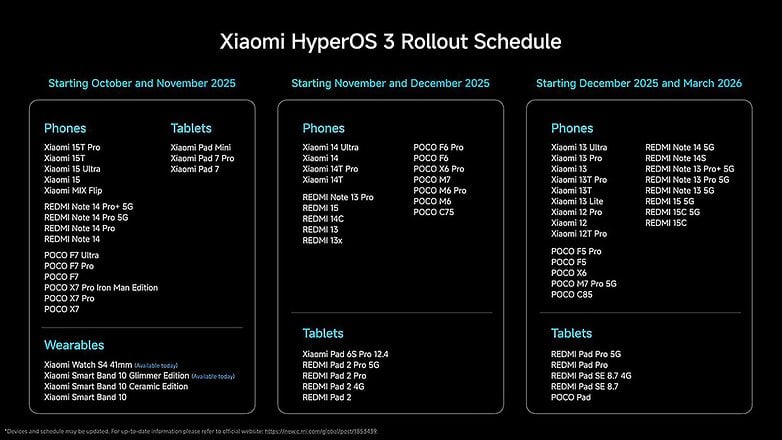
Which Devices Get HyperOS 3.0?
At the end of September 2025, Xiaomi released the full list of smartphones, tablets, and wearables eligible for the HyperOS 3.0 update. Leading the rollout are the Xiaomi 15 series and the newly launched Xiaomi 15T duo. Mid-range additions include the Redmi Note 14 and Note 14 Pro series, along with the Poco X7 and F7.
More devices will follow in November and December, with the full rollout expected to conclude by March 2026.
Xiaomi HyperOS 3.0 Beta Eligible Devices
| October to November 2025 | November to December 2025 | December 2025 to March 2026 |
|---|---|---|
| Xiaomi 15 | Xiaomi 14 | Xiaomi 13 |
| Xiaomi 15 Pro | Xiaomi 14 Ultra | Xiaomi 13 Pro |
| Xiaomi 15 Ultra | Xiaomi 14T | Xiaomi 13 Ultra |
| Xiaomi 15T | Xiaomi 14T Pro | Xiaomi 13 Lite |
| Xiaomi 15T Pro | Xiaomi Pad 6S Pro 12.4 | Xiaomi 13T |
| Xiao Mix Flip | Redmi 13 | Xiaomi 13T Pro |
| Xiaomi Pad Mini | Redmi 13x | Xiaomi 12 |
| Xiaomi Pad 7 Pro | Redmi 14C | Xiaomi 12 Pro |
| Xiaomi Pad 7 | Redmi 15 | Xiaomi 12T Pro |
| Redmi Note 14 Pro+ 5G | Redmi Note 13 Pro | Redmi Note 13 5G |
| Redmi Note 14 Pro 5G | Redmi Pad 2 | Redmi Note 13 Pro 5G |
| Redmi Note 14 Pro | Redmi Pad 2 4G | Redmi Note 13 Pro+ 5G |
| Redmi Note 14 | Redmi Pad 2 Pro | Redmi Note 14S |
| Poco F7 | Redmi Pad 2 Pro 5G | Redmi Note 14 5G |
| Poco F7 Pro | Poco F6 | Redmi 15 5G |
| Poco F7 Ultra | Poco F6 Pro | Redmi 15C |
| Poco X7 | Poco M6 | Redmi 15C 5G |
| Poco X7 Pro | Poco M6 Pro | Redmi Pad Pro 5G |
| Poco X7 Pro Iron Man | Poco M7 | Redmi Pad SE 8.7 |
| Xiaomi Smart Band 10 | Poco X6 Pro | Poco F5 |
| Smart Band 10 Ceramic Edition | Poco C75 | Poco F5 Pro |
| Smart Band 10 Glimmer Edition | Poco X6 | |
| Xiaomi Watch S4 | Poco M7 Pro 5G | |
| Poco C85 | ||
| Poco Pad |
Is your Xiaomi device included in the list? Will you be updating to HyperOS 3.0 beta once it becomes available on your device? Share your plans with us in the comments.
Source: MI
